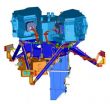(Press-News.org) MINNEAPOLIS/ST.PAUL (October 1, 2010) – After a major review of scientific information, six leading tobacco research and policy experts have concluded that a nicotine reduction strategy should be an urgent research priority because of its potential to profoundly reduce the death and disease from tobacco use. Their findings were published today in the journal Tobacco Control.
According to this new report, reducing the amount of nicotine in cigarettes to non-addictive levels could have a significant public health impact on prevention and smoking cessation. Over time, the move could dramatically reduce the number of annual deaths related to cigarette smoking by decreasing adolescent experimentation with cigarettes preventing a progression to addiction, and by reducing dependence on tobacco among currently addicted smokers of all ages.
Dorothy Hatsukami, Ph.D., University of Minnesota Medical School, and Mitch Zeller, J.D., Pinney Associates in Bethesda, MD, led the overall effort as co-chairs of the National Cancer Institute's Tobacco Harm Reduction Network. They convened several meetings of researchers, policy makers, tobacco control advocates and government representatives that explored the science base for a nicotine reduction strategy.
Currently, about 44 million (or 20 percent) of adults in the United States smoke cigarettes. Other research cited by the authors had found that reducing nicotine to non-addictive levels could potentially reduce smoking prevalence to about 5 percent.
"Nicotine addiction sustains tobacco use. Quitting tobacco can be as difficult to overcome as heroin or cocaine addiction," said Hatsukami, director of the University of Minnesota's Tobacco Use Research Center and the Masonic Cancer Center's Cancer Control and Prevention Research Program "Reducing the nicotine in cigarettes to a level that is non-addicting could have a profound impact on reducing death and disability related to cigarettes and improving overall public health."
Hatsukami adds that studies to date have found that substantial reduction in nicotine in cigarettes does not lead to smokers smoking more lower-nicotine cigarettes because it is harder to compensate for very low nicotine intake.
"In addition, studies have shown a significantly lower number of cigarettes are smoked when low-nicotine cigarettes are used, resulting in eventual abstinence in a considerable number of smokers," she said.
"Imagine a world where the only cigarettes that kids could experiment with would neither create nor sustain addiction," Zeller said. "The public health impact of this would be enormous if we can prevent youthful experimentation from progressing to regular smoking, addiction, and the resulting premature disease and death later. Reducing the nicotine content in cigarettes may be a very effective way to accomplish this major impact," he added.
Hatsukami, Zeller, and their colleagues recommend engaging scientific, research and government agencies to conduct the necessary research and set priorities and goals as the next step toward determining the feasibility of a nicotine reduction approach.
INFORMATION:
This study was funded by the National Cancer Institute, National Institute on Drug Abuse and the American Legacy Foundation. Other authors of this paper include Drs. Kenneth Perkins (University of Pittsburgh), Mark LeSage (Minneapolis Medical Research Foundation and University Minnesota), David Ashley (formerly at the Centers for Disease Control and Prevention, now at the Food and Drug Administration), Jack Heningfield (Pinney Associates), Neal Benowitz (University of California, San Francisco), Cathy Backinger (National Cancer Institute).
END
A calcium-sensing protein, STIM1, known to activate store-operated calcium channels has been found to also inhibit voltage-operated calcium channels, according to researchers at Temple University.
The researchers published their findings, The Calcium Store Sensor, STIM1, Reciprocally Controls Orai and Cav1.2 Channels, in the Oct. 1 issue of Science magazine (www.sciencemag.org).
Calcium, not just important for bones and teeth, is a universal signaling agent that is pivotal in controlling a wide range of cell functions including fast muscle and nerve responses and slower ...
An analysis of geological records that preserve details of the last known period of global warming has revealed 'startling' results which suggest current targets for limiting climate change are unsafe.
The study by climate change experts at the University of Exeter has important implications for international negotiators aiming to agree binding targets for future greenhouse gas emission targets.
Professor Chris Turney and Dr Richard Jones, both from the University's Department of Geography, have reported a comprehensive study of the Last Interglacial, a period of warming ...
The convergence in the coming year of three cyclical conditions affecting ocean temperatures and weather is likely to create unprecedented challenges for states that depend on water from the Colorado River, a new UCLA study suggests.
"If I were concocting a recipe for a perfect drought, this would be it," said Glen MacDonald, co-author of the study and director of UCLA's Institute of the Environment and Sustainability.
Along with a former graduate student, MacDonald has found that the combination of La Niña with two less commonly known ocean conditions — the Pacific ...
CORVALLIS, Ore. – Faster development of the promising field of cellulosic biofuels – the renewable energy produced from grasses and trees – is being significantly hampered by a "deep and thorny regulatory thicket" that makes almost impossible the use of advanced gene modification methods, researchers say.
In a new study published today in the journal BioScience, scientists argue that major regulatory reforms and possibly new laws are needed to allow cellulosic bioenergy to reach its true potential as a form of renewable energy, and in some cases help reduce greenhouse ...
BUFFALO, N.Y. -- Biomedical researchers at the University at Buffalo have engineered adult stem cells that scientists can grow continuously in culture, a discovery that could speed development of cost-effective treatments for diseases including heart disease, diabetes, immune disorders and neurodegenerative diseases.
UB scientists created the new cell lines – named "MSC Universal" – by genetically altering mesenchymal stem cells, which are found in bone marrow and can differentiate into cell types including bone, cartilage, muscle, fat, and beta-pancreatic islet cells. ...
ROCHESTER, Minn. -- In a review article published in the October issue of Mayo Clinic Proceedings,(http://www.mayoclinicproceedings.com) Mayo Clinic physicians differentiate the ethical and legal permissibility of withholding or withdrawing life-sustaining treatments and accepted comfort measures, specifically palliative sedation, from that of physician-assisted suicide or euthanasia.
Physician reviewers find that palliative sedation has an important place on the continuum of appropriate palliative care. "At the end of life, patient goals often shift to comfort, and removal ...
What does it take to save a species in the 21st century? The specter of climate change, with predicted losses to biodiversity as high as 35 percent, has some scientists and managers considering taking their conservation strategies on the road.
Managed relocation (MR) is literally the physical relocation of endangered or threatened species of plants and animals, by humans, to new, and foreign geographical climes. It addresses the concern that climate shifts may make many species' historical ranges environmentally inhospitable, and that the rapid speed of change and habitat ...
In a "marriage" that U.S. east coast residents would object to, the remnants of Tropical Storm Nicole coupled with an upper level low pressure area have dumped record rainfall from the Carolinas to New England on Sept. 30. The GOES-13 Satellite captured that massive "union" of a system as it begins to push off the northeastern U.S. coast today, Oct. 1.
At 1401 UTC (10:01 a.m. EDT) on Oct. 1, the Geostationary Operational Environmental Satellite called GOES-13 captured a visible image of the extensive cloud cover of this coupled system. The GOES image shows the system's ...
A major instrument due to fly aboard NASA's James Webb Space Telescope is getting its first taste of space in the test facilities at the Rutherford Appleton Laboratory (RAL) in the United Kingdom. The Mid-InfraRed Instrument (MIRI) has been designed to contribute to areas of investigation as diverse as the first light in the early Universe and the formation of planets around other stars.
"The start of space simulation testing of the MIRI is the last major engineering activity needed to enable its delivery to NASA. It represents the culmination of 8 years of work by the ...
The use of computer-aided detection (CAD) is increasing, in both screening and diagnostic mammography, according to a study in the October issue of the Journal of the American College of Radiology (www.jacr.org). CAD software systems highlight and alert the radiologist of abnormal areas of density, mass or calcification on a digitized mammographic image (of the breast) that may indicate the presence of cancer.
Screening mammography is an X-ray exam of the breast that is used as a screening tool to detect early breast cancer in women experiencing no symptoms. Diagnostic ...



